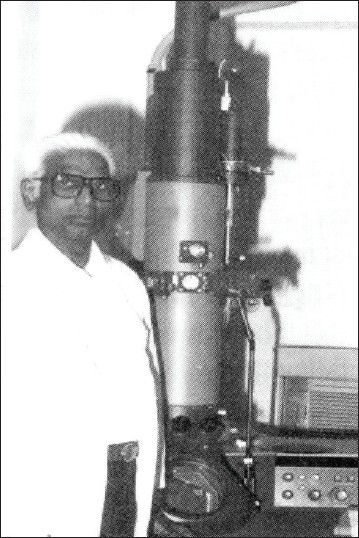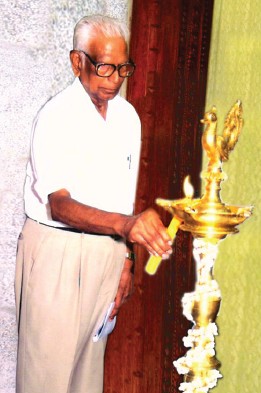Translate this page into:
The eminent Indian leprosy researcher - Dr. C. K. Job
Correspondence Address:
Ramaswamy Premkumar
Schieffelin Institute of Health - Research and Leprosy Centre, Karigiri
India
| How to cite this article: Premkumar R. The eminent Indian leprosy researcher - Dr. C. K. Job. Indian J Dermatol Venereol Leprol 2012;78:223-224 |
Introduction
Recently, the journal Leprosy Review found that Dr. Charles Kamalam Job [Figure - 1] and [Figure - 2] has published more scientific papers in leprosy when compared to all the leprosy research workers in the world. [1] To his credit, there are 314 papers on leprosy in national and international journals, and over 20 papers on general pathology. He also contributed chapters on pathology of leprosy in several text books and monographs.
 |
| Figure 1: Dr. Job was the earliest scientist to use electron microscope in medical research in India, which was installed at CMC-Vellore in 1963 |
 |
| Figure 2: Dr. Job inaugurating the Golden Jubilee Celebrations of Karigiri |
Choosing Leprosy as a Lifetime Career
Dr. C.K. Job was born on 2 nd November 1923 in Madras state, and graduated in science from Travancore in 1942. He obtained MBBS in 1953 from CMC-Vellore and was appointed as a physician in the newly started Schieffelin Leprosy Research Sanatorium (SLRS) at Karigiri, Tamil Nadu, where he worked in the afternoons. In the mornings, he worked as a Registrar in the Dermatology Unit in CMC-Vellore, 20 km from Karigiri. The Leprosy Mission (TLM), a NGO in which he was involved, asked him to help promote leprosy research at this Sanatorium. A major turning point in his life came when he was advised by his Anatomy Professor to learn histopathological techniques if he was keen on research in leprosy, and suggested him to meet the Professor of Pathology. Soon, he joined MD Pathology at CMC-Vellore. After completion of the course in 1959, he shifted to SLRS as a full-time Medical Officer and Pathologist [2] and retained his teaching position in the Pathology Department of CMC-Vellore, visiting one day in a week.
Service Career
Soon, he became the Director of SLRS, a position he held till 1968, and then continued to be a consultant pathologist. He was the Professor of Pathology (1962-1981) and Medical Superintendent and Principal of CMC-Vellore from 1978 to 1981. In 1981, he moved to the United States and served as the Chief of Pathology Research Department of the National Hansen′s Disease Center at Carville, LA, a position he held for 10 years. He was also the Clinical Professor of Pathology at the School of Medicine, Tulane University, New Orleans, LA. He held part-time Consultant position with the Dermatology Institute, Caracas, Venezuela, in 1982; visiting Professor, Postgraduate Institute of Medical Sciences, Chandigarh, in 1971; and as a consultant to the World Health Organization, Geneva, in 1990. From 1992 to the present date, he has served as Consultant Pathologist, St Thomas Hospital and Leprosy Centre, Chettupattu, Tamil Nadu.
Major Contributions
His major research interests are related to the pathology and immunology of leprosy, transmission of leprosy and electron microscopic studies. He described in detail the pathology and pathogenesis of nerve lesions in leprosy using histopathological and electron microscopy studies. He proved beyond any reasonable doubt that invasion of Mycobacterium leprae causes Schwann cell destruction, which initially leads to loss of sensory nerve fibers and then the involvement of motor filaments. [3] Through his extensive studies on transmission of leprosy, he showed that M. leprae enters the body through abrasion in skin and nasal mucosa. His pathological studies with armadillos paved the way for other recent studies to prove that leprosy is a zoonosis in USA. He also made the significant discovery of the causative organism in tropical eosinophilia, and it is still well recognized.
Dr. Job was responsible, for the first time, in India, in 1961, for instituting the Survey Education and Treatment (SET) work in leprosy through the TLM. A large number of patients in villages in different parts of India obtained treatment through this measure in TLM hospitals. Soon, the Central and State governments adopted it as a measure to control leprosy in India.
Fellowships
Dr. Job was named a Fellow of the Academy of Medical Sciences in India (F.A.M.S) in 1971, Fellow of the Royal College of Pathologists (F.R.C.Path) in 1973 from London, Fellow of the Indian College of Pathologists (F.I.C.Path) in 1993 and was Chairman of this Council in 1994. In 1963, he was a Rockefeller Fellow (USA) and in the following year, Nuffield Fellow (London, U K). In 1977-78, he was a Heisser Fellow in Carville, LA.
Main Honours
He was the recipient of the prestigious Damien-Dutton Award in 1993, which is given to those who do outstanding work in leprosy globally. The presentation was made during the 14 th International Leprosy Congress (ILA) in Orlando, Florida. [4] He was President, Indian Association of Leprologists (1972-1973), which in 2009 honored him with Life Time Achievement Award for his devoted scientific work in the field of leprosy.
He was the Honorary Physician (Pathologist) to the President of India from 1981. He was also the Vice President, ILA (1984-1988); Honorary Vice President, International Leprosy Association (1988 to present) and President of the Leprosy Mission International, London (1999-2004).
Summing-Up
Bill Clinton, the then President of the United States, in his letter dated August 19, 1993 to Dr. Job, congratulating him on his receiving the Damien-Dutton Award said, "….I salute you for your contributions to leprosy research and treatment. Your efforts as scientist, writer, innovator, and educator on behalf of victims of leprosy have been significant in the attempt to provide relief and improve lives……" The above appreciation of Bill Clinton is a true tribute to the accomplishment of this eminent Indian leprosy researcher.
He still continues to be the Scientist Emeritus at Karigiri and in St. Thomas Leprosy Centre and Hospital at Chettupattu, Tamil Nadu.
| 1. |
Schoonbaert D, Demedts V. Analysis of the leprosy literature indexed in Medline (1950-2007). Lepr Rev 2008;79:387-400.
[Google Scholar]
|
| 2. |
Premkumar R. The history of a leprosy sanatorium in India. Lepr Rev 2010;81:150-9.
[Google Scholar]
|
| 3. |
Job CK. Work in God's vineyard. In: Job CK, editor. Called to be in His service - Autobiography. 1 st ed. Chennai: Chummy Printers; 2010. p. 95-124.
st ed. Chennai: Chummy Printers; 2010. p. 95-124.'>[Google Scholar]
|
| 4. |
Trautman JR. Eminent Indian HD researcher honoured. The Star 1993;3:1.
[Google Scholar]
|
Fulltext Views
4,557
PDF downloads
3,098





